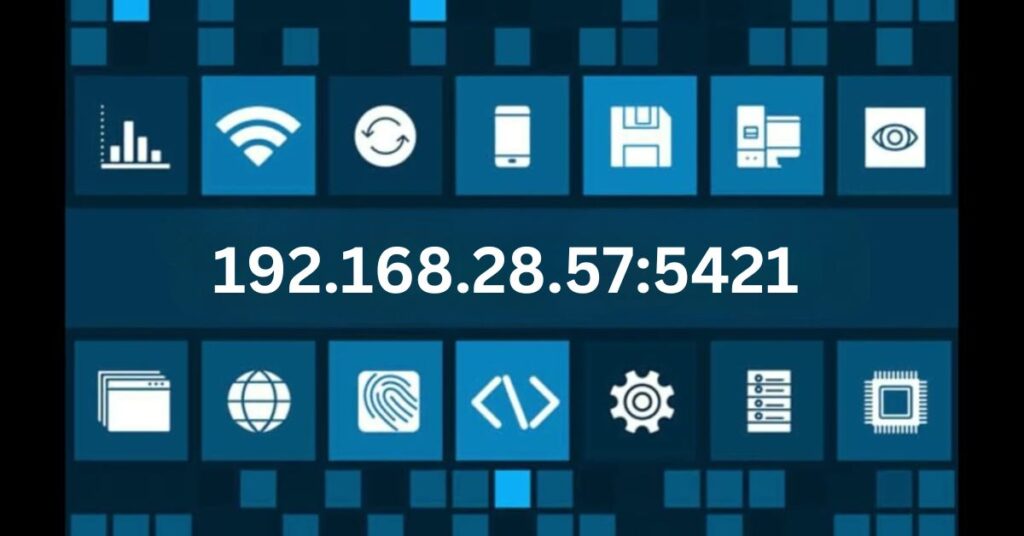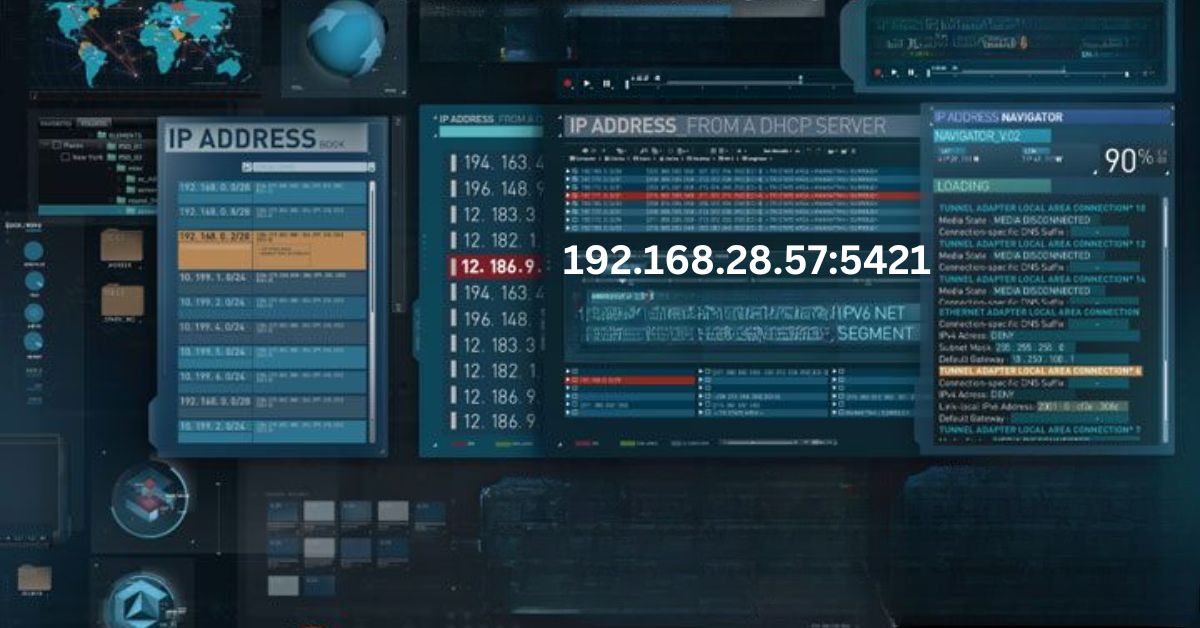In the world of local network management, understanding specific IP addresses and ports is essential for efficient communication. One such combination, 192.168.28.57:5421, plays a crucial role in enabling devices and services to interact smoothly within a private network.
For anyone managing a small office or home network, mastering the basics of IP addresses and port configurations can greatly improve your system’s performance. Properly assigning and managing 192.168.28.57 with port 5421 can streamline data flow, enhance security, and prevent service disruptions.
This guide will take you through the essential steps of accessing and managing 192.168.28.57:5421. From configuring the IP address to securing the port, you’ll learn how to optimize your network and ensure seamless device communication.
Also read this blog: Construction ERP Software News.ticbus.com
Decoding the Mystery: What is 192.168.28.57:5421?
At its core, 192.168.28.57:5421 is a combination of an IP address and a port number. The IP address (192.168.28.57) identifies a specific device on your local network, while the port number (5421) pinpoints a particular service or application running on that device. This pairing allows for precise communication and data routing within your network.
Understanding this combination is crucial for effective local network configuration. It enables you to direct traffic, set up services, and troubleshoot issues with greater accuracy. Let’s break down each component to see how they work together in creating a robust network infrastructure.
The IP Address: 192.168.28.57 Explained
The IP address 192.168.28.57 falls within the private IP range, specifically designed for use in local networks. It’s part of the IPv4 addressing scheme, where each number separated by dots represents an octet ranging from 0 to 255.
Port 5421: Opening Doors for Services
Port 5421 is a specific channel that allows data to flow to and from a particular service on your device. While some ports are standardized (like 80 for HTTP), 5421 is often used for custom applications or services in local network configurations.
The Power of Combination: IP and Port Working Together
When combined, 192.168.28.57:5421 creates a unique identifier for a specific service on a particular device within your local network. This precision is key to efficient data routing and service management in complex network environments.
Also read this blog: OEX Power Module for Table: Exploring the Versatility
Setting Up Your Local Network with 192.168.28.57:5421
Configuring your local network to use 192.168.28.57:5421 involves a few key steps. First, you’ll need to assign the IP address to a device on your network. Then, you’ll configure the chosen service or application to use port 5421. This process lays the foundation for effective local network management.
By following best practices in local network configuration, you can ensure optimal performance and security. Let’s explore the specific steps involved in setting up this IP and port combination, as well as some common pitfalls to avoid.
Assigning the IP Address 192.168.28.57
To assign 192.168.28.57 to a device, access your router’s settings or use the device’s network configuration panel. Ensure the IP is within your network’s subnet and doesn’t conflict with other devices.
Configuring Services to Use Port 5421
Once the IP is set, configure your chosen service or application to listen on port 5421. This often involves editing configuration files or using the application’s settings menu to specify the port number.
Testing Your Configuration
After setup, test your configuration by attempting to access the service from another device on the network. Use the full address (192.168.28.57:5421) to ensure you’re targeting the correct IP and port combination.
Security Considerations for 192.168.28.57:5421

While 192.168.28.57:5421 is used within a local network, security should still be a top priority. Unauthorized access to services, even within your network, can lead to data breaches or system compromises. Implementing strong security measures is crucial for protecting your local network configuration.
Effective security involves a multi-layered approach, combining firewalls, access controls, and regular monitoring. Let’s explore some key security considerations and best practices to keep your 192.168.28.57:5421 configuration safe and secure.
Security Tips for Protecting 192.168.28.57:5421:
- Use strong access controls.
- Regularly update firewall rules.
- Monitor for unusual traffic patterns
Implementing Firewall Rules
Configure your firewall to control access to 192.168.28.57:5421. Set up rules that allow only necessary traffic and block potential threats, enhancing your local network security.
Access Control and Authentication
Implement strong authentication methods for services running on 192.168.28.57:5421. Use complex passwords, two-factor authentication, or certificate-based access to prevent unauthorized use.
Regular Security Audits
Conduct periodic security audits of your local network configuration. Check for vulnerabilities, update software, and review access logs to ensure your 192.168.28.57:5421 setup remains secure.
Also read this blog: BigBoxRatio.com: Tech-Driven Insights to Optimise Retail Operations
Troubleshooting Common Issues with 192.168.28.57:5421

Even with careful setup, issues can arise when working with 192.168.28.57:5421. Common problems include connectivity issues, port conflicts, or misconfigured services. Knowing how to troubleshoot these issues is essential for maintaining a smooth-running local network.
Effective troubleshooting involves a systematic approach, starting with basic checks and progressing to more advanced diagnostics. Let’s explore some common issues you might encounter and the steps to resolve them, ensuring your local network configuration remains robust and reliable.
Connectivity Problems
If you can’t connect to 192.168.28.57:5421, check your network connection, verify the IP assignment, and ensure the service is running. Use ping and telnet commands to test basic connectivity.
Port Conflicts and Availability
Ensure port 5421 isn’t being used by another service. Use netstat or similar tools to check port usage and resolve any conflicts in your local network configuration.
Service Configuration Issues
If the service on port 5421 isn’t responding correctly, review its configuration files. Check for syntax errors, incorrect IP bindings, or mismatched port settings that could affect its operation.
Advanced Techniques for Managing 192.168.28.57:5421
As you become more comfortable with basic local network configuration, you can explore advanced techniques to optimize your 192.168.28.57:5421 setup. These methods can enhance performance, improve security, and provide greater flexibility in managing your network.
Advanced management often involves tools and techniques that give you deeper insight into your network’s operation. Let’s look at some advanced strategies that can take your local network configuration to the next level.
Port Forwarding and NAT
Learn to use port forwarding and Network Address Translation (NAT) to make services on 192.168.28.57:5421 accessible from outside your local network, if needed.
Traffic Monitoring and Analysis
Implement network monitoring tools to analyze traffic patterns on 192.168.28.57:5421. This can help identify performance issues, security threats, or unusual behavior in your local network.
Load Balancing and Failover
For critical services, consider setting up load balancing or failover mechanisms. This ensures continuous availability even if the primary instance of 192.168.28.57:5421 experiences issues.
Future-Proofing Your Local Network Configuration
As technology evolves, so do networking standards and practices. While 192.168.28.57:5421 is effective for current local network configurations, it’s important to consider future developments. Staying informed about emerging technologies and trends can help you make informed decisions about your network’s future.
Preparing for the future involves understanding upcoming networking standards, considering scalability, and planning for potential upgrades. Let’s explore some key considerations for future-proofing your local network configuration and ensuring it remains effective in the years to come.
IPv6 and Its Impact
Understand how the transition to IPv6 might affect your local network configuration. While 192.168.28.57 is an IPv4 address, learning about IPv6 addressing can prepare you for future changes.
Emerging Network Technologies
Stay informed about new networking technologies like software-defined networking (SDN) or intent-based networking. These might offer new ways to manage and optimize your local network configuration.
Scalability and Growth Planning
Plan for network growth by understanding how to expand your IP range and manage additional devices and services. This ensures your local network configuration can adapt to changing needs.
FAQ’S
Why is 192.168.28.57 considered a private IP address?
192.168.28.57 is part of the private IPv4 range, reserved for local networks, meaning it’s not accessible from the public internet.
How can I find out what service uses port 5421 on my network?
You can use network tools like *netstat* or *Nmap* to identify the service associated with port 5421 on your network.
Is the IP address 192.168.28.57:5421 safe to use?
Yes, it’s safe within a private network, but ensure proper security configurations, like firewalls, to prevent unauthorized access.
Conclusion
Understanding and managing 192.168.28.57:5421 is essential for maintaining a well-functioning local network. By correctly configuring the IP address and port, you can optimize network performance, enhance security, and prevent conflicts between services. Regular monitoring and maintenance will ensure smooth operations and help you troubleshoot any issues that may arise. Whether used for local hosting, testing, or securing specific applications, mastering these basics will give you greater control over your network and help you manage resources more effectively.

BagisPack.com: Your ultimate travel companion. Explore expert travel tips, packing guides, and destination insights. Empowering adventurers with essential advice for seamless journeys around the globe.








